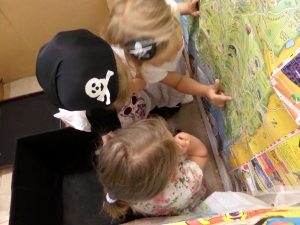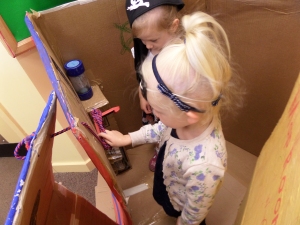Friday 6th June 2014
Today was the first day that I noticed two boys in nursery openly challenging girls who tried to join in…
The first case was at the construction area outside. I was actively supporting children in trying areas not in use. I entered the construction area and one of the boys followed. We started to move bricks, level with a spirit level and measure. One of the girls moved to the area and asked the boy whether she could join us. “No” she was told. I challenged with “Why not?” “Building is for big men,” was the reply, “you have big men and boys not girls.” I challenged with “Girls build as well as boys.” “No they don’t. I told you it’s big men and boys” the boy said. I challenged again with “What makes girls different to boys to stop them?” I then supported understanding with a conversation that highlighted that girls could do the same as boys. The girl returned and her friend joined in. The boy accepted the girls as I had challenged him but I’m not convinced he would have let them without my presence.
Then later children were in the middle of role-play supporting fantasy with wooden block play. “Lets go to our boys castle,” one of the boys called. “Just boys?” I challenged, “Why just boys? Why not girls?” “The castle is for super heroes and you can’t have girl super heroes.” I named a handful. “They have Cat Woman but she is bad. She is not a super hero” was the answer. I then named similar villains who were boys. I could see he was reflecting on his thoughts through being challenged. He was persuaded to let the girls enter the castle.
Both examples today were in areas of construction and outdoors.
My next observation will be to see if they are more open to girls joining in next week? Will I need to intervene?
Monday June 9th 2014
The children were under the shelter while it rained, singing to a Disney song. The music stopped and another song was about to start. The song started but the three girls said nothing. “We’re not singing this one. It’s a boys song.” The comment was directed at a boy sat opposite. I intervened with interest. “Why are you not singing?” pretending I hadn’t heard. “It’s a boys song. Boys have to sing this song.” I challenged the statement suggesting that songs were for everyone to sing. “Some songs are for boys and some are for girls.” One of the boys joined in, “Yes this is a boys song.” The song changed with a female singing. “I’m singing this one,” the girls laughed. “You can’t. It’s for girls this song.” I then demonstrated that songs are for everyone by singing the song with them.
The children had fixed ideas as to who sang the song in the soundtrack from the film. Young children are trying to partition boys and girls songs when we all know that anyone can sing a song. By challenging I would hope that they could sing the songs they enjoy without considering their gender.
Pirates for All
It’s the last term prior to the summer so we are exploring the seaside. ‘Pirates’ is the chosen starting point. The resources, if the practitioners don’t evaluate, are very male dominated. My colleague came across a story which has female pirates, ‘The Night Pirates’ by Peter Harris and Deborah Allwright. She used this as the hook. We used Word Wall to create a lotto game. Initially I found the images centred around men and boys. I refined the search with the words ‘girl pirates.’ This provided me with various images that made the game more inclusive to both girls and boys. Instead of the small world toys from the shops with just pirate men we have used non-specific play people. We hope that the two-week theme will help develop strong characters amongst both boys and girls.


